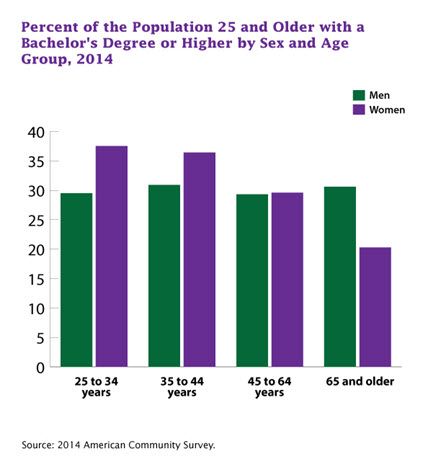Women Now at the Head of the Class, Lead Men in College Attainment
Women Now at the Head of the Class, Lead Men in College Attainment
In 1940, under 5 percent of the U.S. population held a bachelor’s degree. Men, at 5.5 percent, were more likely than women at 3.8 percent, to have a college education. Although the 1.7 percentage point gap may appear small, it was big relative to the portion of women with bachelor’s degrees (it would have taken a 45 percent increase among women for them to match men).
Now, nearly 75 years after the Census Bureau began collecting these statistics, the educational attainment of our population has increased to 30 percent -and the gender balance has shifted. For the first time since measurement began in 1940, women were more likely than men to have a bachelor’s degree.
Figure 1 shows how things have changed in the last decade (from 2005 to 2014). Data from the American Community Survey show that in 2005, 28.5 percent of men had a bachelor’s degree or higher, compared with 26.0 percent of women. In 2014, the percentage for men was 29.9, while that for women was 30.2, marking the first year that women’s college attainment was statistically higher than men’s college attainment.
The trend toward higher education started with younger women. A 2004 publication noted that since 1996, young women age 25 to 29 have had higher college attainment rates than young men. However, the pattern for older men and women is different. Figure 2 shows that among women aged 25 to 34, 37.5 percent have completed a bachelor’s or higher degree, compared with 29.5 percent of men. Among women 65 and older, 20.3 percent had a bachelor’s degree, compared with 30.6 percent of men.
Figure 3 shows how women’s attainment stands relative to men across the 50 states. In some states, such as Alaska, North Dakota and Mississippi, a greater portion of women than men have completed a bachelor’s degree or higher. In other states, like Washington, Idaho and Utah, men are more likely to have a college degree.
What will the future bring? In the near future, women’s college attainment will continue to grow relative to men’s attainment, simply as a result of younger people replacing older generations. On the other hand, there is some evidence that young men may have started to keep up with young women. In the past five years, college attainment of people aged 25 to 34 has increased about as much for both women and men (2.4 percentage points for men, 2.6 percentage points for women – these estimates are not statistically different from one another).
For more information on education products, including data on school enrollment, educational attainment and field of bachelor’s degree, visit the Census Bureau’s education home page.






